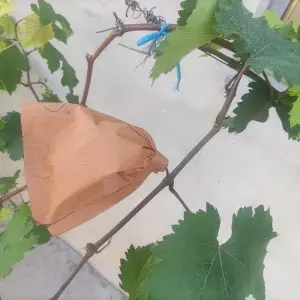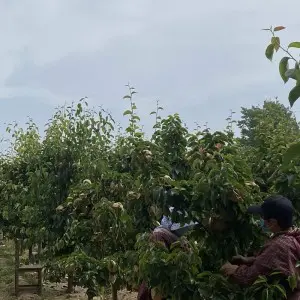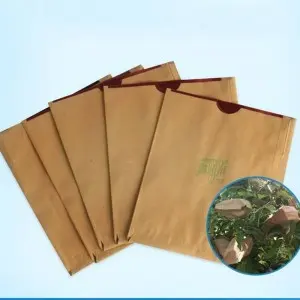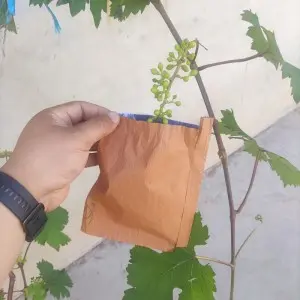Oct . 16, 2025 12:00 Back to list
Fruit Paper Bags - Eco Pollen Block, Waterproof, Breathable
Fruit bagging goes mainstream: a field note from orchards that care about residue, color, and pack-out
If you’ve spent any time in a modern orchard, you’ve seen it: rows of apples and pears wearing tiny paper jackets. These fruit paper bags aren’t a fad; they’re a practical response to residue limits, cosmetic standards, and unpredictable weather. To be honest, I was skeptical years ago—until growers started showing me their pack-out data.

What’s driving the shift
Two forces: sustainability and risk control. Retail buyers want lower pesticide residues (Codex and retailer MRLs are tough), while growers need consistent color and fewer defects. It seems that paper-bagged fruit often achieves deeper background color thanks to controlled light exposure and stress reduction. In fact, many customers say bagging trimmed their pesticide sprays and gave a cleaner finish, especially on high-value cultivars.

Product spotlight: FRUIT PAPER BAGS FOR PREVENTING INSECTS AND PESTICIDE RESIDUES IN ORCHARDS
Origin: Caozhuang Development Zone, Fanzhuang Town, Zhao County, Shijiazhuang, Hebei Province. The design promotes anthocyanin background color, reduces insect and disease pressure, and shields fruit from wind-rub and rain splash—so, fewer mechanical defects and lower visible residue. Storage and transport? Usually better, because you’re packing sounder fruit.
| Spec | Details (≈ values; real-world use may vary) |
|---|---|
| Paper grade | FSC kraft, 70–90 gsm; optional food-contact coating (wax/biopolymer) |
| Layers | Single or duplex (inner light-shield/UV layer) |
| Cobb (ISO 535) | ≈ 25–35 g/m² (water-resistant grade) |
| Burst strength (ISO 2758) | ≥ 2.0 kPa·m²/g |
| UV attenuation | Up to 95% UV-A reduction, cultivars dependent |
| Vent design | Micro-perf or slits to avoid humidity build-up |
| Closure | Fold-over wire tie or twist tab |
| Service life | One season in-orchard; 12 months shelf life dry-stored |
| Compliance | GB 4806.8 food-contact paper; BfR XXXVI; EN 13432 options |

Process and testing (how it’s made and verified)
- Materials: food-grade kraft (ISO 536 grammage checked), optional inner UV/anti-wet layer.
- Methods: precision die-cut, venting micro-perfs, heat/wax coating where specified.
- QC and lab: Cobb (ISO 535), burst (ISO 2758), tensile (ISO 1924-2), migration vs GB 4806.8 and BfR.
- Field validation: bag 30–45 days pre-harvest; remove 7–14 days before pick for color finish, cultivar dependent.

Where they shine (and what growers say)
- Apples, pears, peaches, mangos, loquat, grape bunches—high-value lots where finish matters.
- Advantages: lower visible residues, fewer insect stings, reduced wind-rub, tighter grade distribution.
- Customer feedback: “Pack-out +8–15% on export blocks”; “Spray intervals stretched without quality loss.”

Vendor snapshot (quick comparison)
| Vendor | Origin | Lead time | Certs | Notes |
|---|---|---|---|---|
| JML (this product) | Zhao County, Hebei | ≈ 10–20 days | GB 4806.8, BfR | Duplex UV option; low MOQ for trials |
| Vendor A | Domestic | ≈ 20–30 days | Food-contact claim | Basic kraft; limited sizes |
| Vendor B | Import | ≈ 30–45 days | EN 13432 | Compostable inner; higher price |

Customization tips
- Size to fruit caliper; allow growth room.
- Pick UV/light level by cultivar: e.g., red blush apples like partial block with final sun-finish.
- Vent pattern for humid sites; add water-repellent for monsoon blocks.
- Print lot/harvest codes; sustainability logos if EN 13432-grade is chosen.
Mini case studies
- Northern apple farm: duplex fruit paper bags cut insect sting by ≈45% and boosted export pack-out +12% vs unbagged rows (n=6 blocks).
- Subtropical mango: waxed fruit paper bags reduced rain-splash blemish by ≈30% and improved color uniformity score by 0.8 points (internal QC scale).

Standards and citations
- GB 4806.8-2016: National standard for paper and paperboard in contact with food (China).
- BfR Recommendation XXXVI: Paper and board for food contact (Germany).
- ISO 535: Paper and board — Determination of water absorptiveness (Cobb method).
- ISO 2758: Paper — Determination of bursting strength.
- ISO 536: Paper and board — Determination of grammage.
- EN 13432: Requirements for packaging recoverable through composting and biodegradation.
- FAO: Integrated Pest Management in horticulture; Codex MRL framework for pesticide residues.
-
Comprehensive Guide to CE Certification Apricot Pollen Health Benefits
NewsNov.24,2025
-
CE Certification Mango Fruit Protection Bags: Enhancing Export Quality & Sustainability
NewsNov.23,2025
-
CE Certification Varieties Suitable for Collecting Apple Pollen – Ensuring Quality & Compliance in Apple Breeding
NewsNov.22,2025
-
Comprehensive Guide to CE Certification Mango Cover Bags – Quality, Standards & Trends
NewsNov.22,2025
-
What You Need to Know About CE Certification Peach Blossom Powder Keto
NewsNov.21,2025
-
CE Certification Pear Pollen Collection Base – Ensuring Quality & Sustainability in Global Horticulture
NewsNov.20,2025